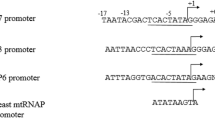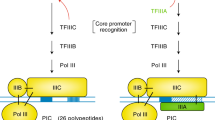Abstract
E. coli RNA polymerase (RNAP) is a multisubunit enzyme with a molecular mass of nearly half a million. The major form of RNAP in cells consists of core enzyme (subunit composition ββ′α2) in complex with the σ70 factor. σ70 is 613 amino acids in length: sequence comparisons show that it shares four regions of amino acid sequence similarity with other σ factors (regions 1, 2, 3 and 4: Fig. 1; Gross et al. 1992). It has long been known that RNAP containing σ70, is competent to initiate transcription at many promoters in the absence of any activator protein and that the σ70 subunit is essential for recognition of these promoters.
Access this chapter
Tax calculation will be finalised at checkout
Purchases are for personal use only
Preview
Unable to display preview. Download preview PDF.
Similar content being viewed by others
References
Backendorf C, Brandsma J, Kartasova T, van de Putte P (1983) In vivo regulation of the uvrA gene: role of -10 and -35 promoter regions. Nucleic Acids Res 11:5795–5810
Barne K, Bown J, Busby S, Minchin S (1997) Region 2.5 of the RNA polymerase σ70 subunit is responsible for the recognition of the “extended - 10 motif” at promoters. EMBO J. in the press
Belyaeva T, Griffiths L, Minchin S, Cole J, Busby S (1993) The Escherichia coli cysG promoter belongs to the “extended -10” class of bacterial promoters. Biochem J 296:851–857
Bingham A, Ponnambalam S, Chan B, Busby S (1986) Mutations that reduce expression from the P2 promoter of the Escherichia coli galactose operon. Gene 41:67–74
Brosius J, Cate R, Perlmutter A (1982) Precise location of two promoters for the β lactamase gene of pBR322. J Biol Chem 257:9205–9210
Burns H (1996) Factors affecting open complex formation by Escherichia coli RNA polymerase. PhD Thesis, University of Birmingham, Birmingham
Burns H, Minchin S (1994) Thermal energy requirement for strand separation during transcription initiation: the effect of supercoiling and extended protein DNA contacts. Nucleic Acids Res 22:3840–3845
Burns H, Belyaeva T, Busby S, Minchin S (1996) Temperature dependence of open complex formation at two E. coli promoters with extended -10 sequences. Biochem J 317:305–311
Busby S, Spassky A, Chan B (1987) RNA polymerase makes important contacts upstream from base pair -49 at the Escherichia coli galactose operon P1 promoter. Gene 53:145–152
Chan B, Busby S (1989) Recognition of nucleotide sequences at the Escherichia coli galactose operon P1 promoter by RNA polymerase. Gene 84:227–236
Chan B, Spassky A, Busby S (1990) The organisation of open complexes between Escherichia coli RNA polymerase and DNA fragments carrying promoters either with or without consensus -35 region sequences. Biochem J 270:141–148
Dombroski A, Walter W, Record T, Siegele D, Gross C (1992) Polypeptides containing highly conserved regions of transcription initiation factor σ70 exhibit specificity of binding to promoter DNA. Cell 70:510–512
Graves M, Rabinowitz J (1986) In vivo and in vitro transcription of the Clostridium pasteurianum ferredoxin gene. Evidence for “extended” promoter elements in gram-positive organisms. J Biol Chem 261:11409–11415
Grimes E, Busby S, Minchin S (1991) Different thermal energy requirement for open complex formation by Escherichia coli RNA polymerase at two related promoters. Nucleic Acids Res 19:6113–6118
Gross C, Lonetto M, Losick R (1992) Bacterial sigma factors. In: McKnight S, Yamamoto K (eds) Transcriptional regulation, vol 1. Cold Spring Harbor Laboratory Press, Cold Spring Harbor, pp 129–176
Harley C Reynolds R (1987) Analysis of E. coli promoter sequences. Nucleic Acids Res 15:2343–2361
Hawley D, McClure W (1983) Compilation and analysis of Escherichia coli promoter DNA sequences. Nucleic Acids Res 11:2237–2255
Hellinga H, Evans P (1985) Nucleotide sequence and high level expression of the major Escherichia coli phosphofructokinase. Eur J Biochem 149:363–373
Helmann J (1995) Compilation and analysis of Bacillus subtilis σA-dependent promoter sequences: evidence for extended contact between RNA polymerase and upstream promoter DNA. Nucleic Acids Res 23:2351–2360
Hinton D, March-Amegadzie R, Gerber J, Sharma M (1996) Characterisation of pre-transcription complexes made at a bacteriophage T4 middle promoter: involvement of the T4 Mot A activator and the T4 AsiA protein, a σ 70 binding protein, in the formation of the open complex. J Mol Biol 256:235–248
Inokuchi K, Furukawa H, Nakamura K, Mizushima S (1984) Characterisation by deletion mutagenesis in vitro of the promoter region of ompF. J Mol Biol 178:653–668
Johnston F, Ponnambalam S, Busby S (1987) Binding of Escherichia coli RNA polymerase to a promoter carrying mutations that stop transcription initiation. J Mol Biol 195:745–748
Keilty S, Rosenberg M (1987) Constitutive function of a positively regulated promoter reveals new sequences essential for activity. J Biol Chem 262:6389–6395
Kumar A, Malloch R, Fujita N, Smillie D, Ishihama A, Hayward R (1993) The –35 recognition region of Escherichia coli σ70 is inessential for initiation of transcription at an “extended minus 10” promoter. J Mol Biol 232:406–418
Lisser S, Margalit H (1993) Compilation of E. coli mRNA promoter sequences. Nucleic Acids Res 21:1507–1516
McClure W (1985) Mechanism and control of transcription initiation in procaryotes. Annu Rev Biochem 54:171–204
Minchin S, Busby S (1993) Location of close contacts between Escherichia coli RNA polymerase and guanine residues at promoters either with or without consensus - 35 region sequences. Biochem J 289:771–775
Musso R, diLauro R, Adhya S, de Crombrugghe R (1977) Dual control for transcription of the galactose operon by cyclic AMP and its receptor protein and two interspersed promoters. Cell 12:847–854
Ponnambalam S, Webster C, Bingham A, Busby S (1986) Transcription initiation at the Escherichia coli galactose operon promoters in the absence of the normal -35 region sequences. J Biol Chem 261:16043–16048
Ponnambalam S, Chan B, Busby S (1988) Functional analysis of different sequence elements in the Eschericia coli galactose operon P2 promoter. Mol Microbiol 2:165–172
Ross W, Gosink K, Salomon J, Igarashi K, Zou C, Ishihama A, Severinov K, Gourse R (1993) A third recognition element in bacterial promoters: DNA binding by the α subunit of RNA polymerase. Science 262:1407–1413
Sabelnikov A, Greenberg B, Lacks S (1995) An extended –10 promoter alone directs transcription of the DpnII operon of Streptococcus pneumoniae J. Mol Biol 250:144–155
Voskuil M, Voepel K, Chambliss G (1995) The –16 region, a vital sequence for the utilization of a promoter in Bacillus subtilis and Escherichia coli. Mol Microbiol 17:271–279
Yura T (1996) Regulation and conservation of the heat shock transcription factor σ32. Genes Cells 1:277–284
Author information
Authors and Affiliations
Editor information
Editors and Affiliations
Rights and permissions
Copyright information
© 1997 Springer-Verlag Berlin Heidelberg
About this chapter
Cite this chapter
Bown, J.A., Barne, K.A., Minchin, S.D., Busby, S.J.W. (1997). Extended —10 Promoters. In: Eckstein, F., Lilley, D.M.J. (eds) Mechanisms of Transcription. Nucleic Acids and Molecular Biology, vol 11. Springer, Berlin, Heidelberg. https://doi.org/10.1007/978-3-642-60691-5_4
Download citation
DOI: https://doi.org/10.1007/978-3-642-60691-5_4
Publisher Name: Springer, Berlin, Heidelberg
Print ISBN: 978-3-642-64509-9
Online ISBN: 978-3-642-60691-5
eBook Packages: Springer Book Archive




